HR Strategies for Cultural, Ethical, & CSR Issues in Banking Canada
VerifiedAdded on 2023/06/03
|12
|2372
|465
Report
AI Summary
This report analyzes Human Resource Management (HRM) strategies to address cultural, ethical, and Corporate Social Responsibility (CSR) issues within a Canadian multinational bank. It identifies measures for issue identification, such as feedback forms and diversity analysis, and assesses their impact on the organization and staff. The report proposes HR strategies to enhance cultural competency, ethical behavior, and CSR practices, emphasizing employee involvement and transparency. It also examines potential issues arising from these strategies and suggests mitigation techniques, including training and succession planning. A monitoring plan, focusing on employee and customer satisfaction rates, is outlined to evaluate the effectiveness of the implemented HR strategies. The collaboration between the HR department and employees is crucial for the success of the implementation.
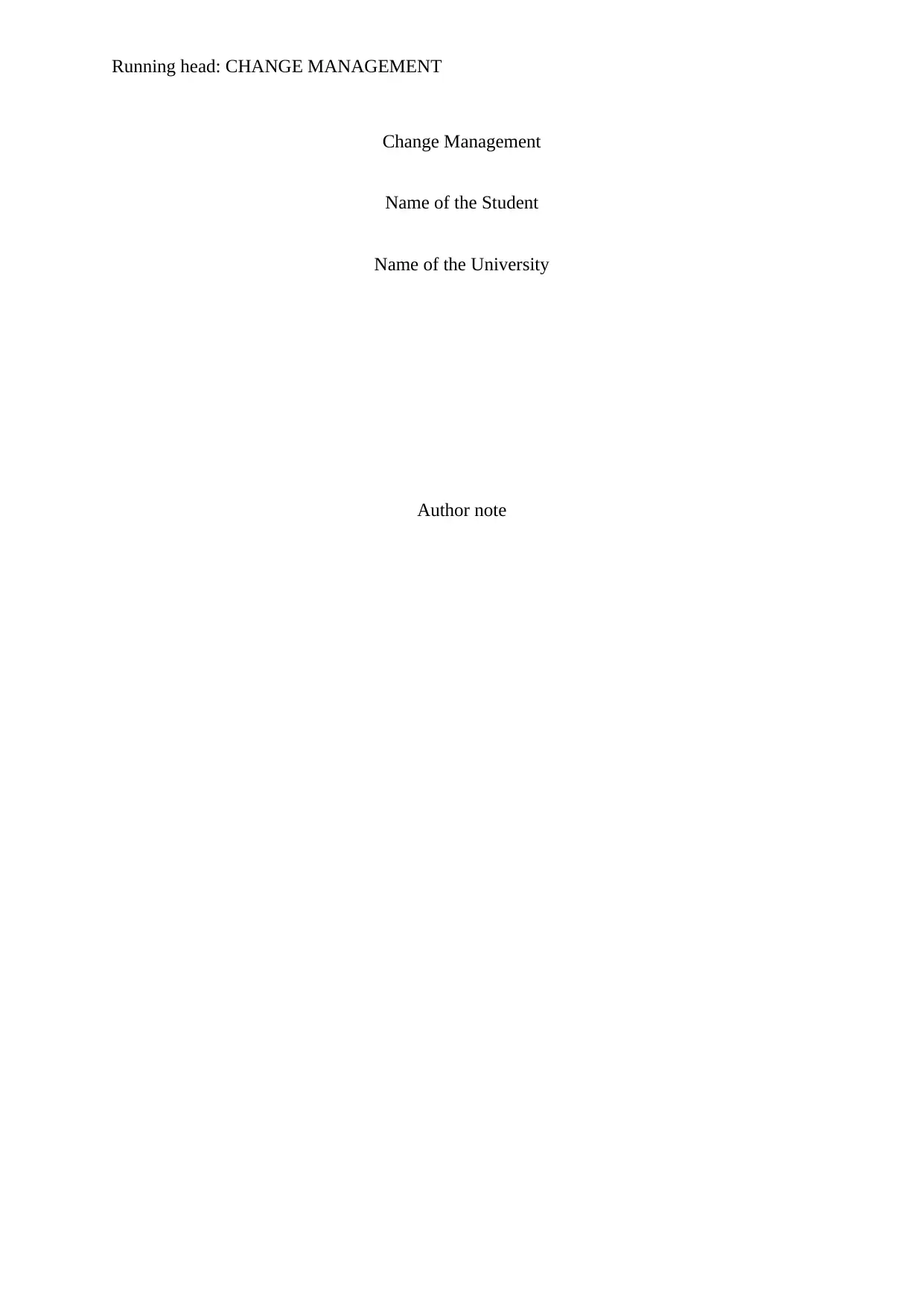
Running head: CHANGE MANAGEMENT
Change Management
Name of the Student
Name of the University
Author note
Change Management
Name of the Student
Name of the University
Author note
Paraphrase This Document
Need a fresh take? Get an instant paraphrase of this document with our AI Paraphraser
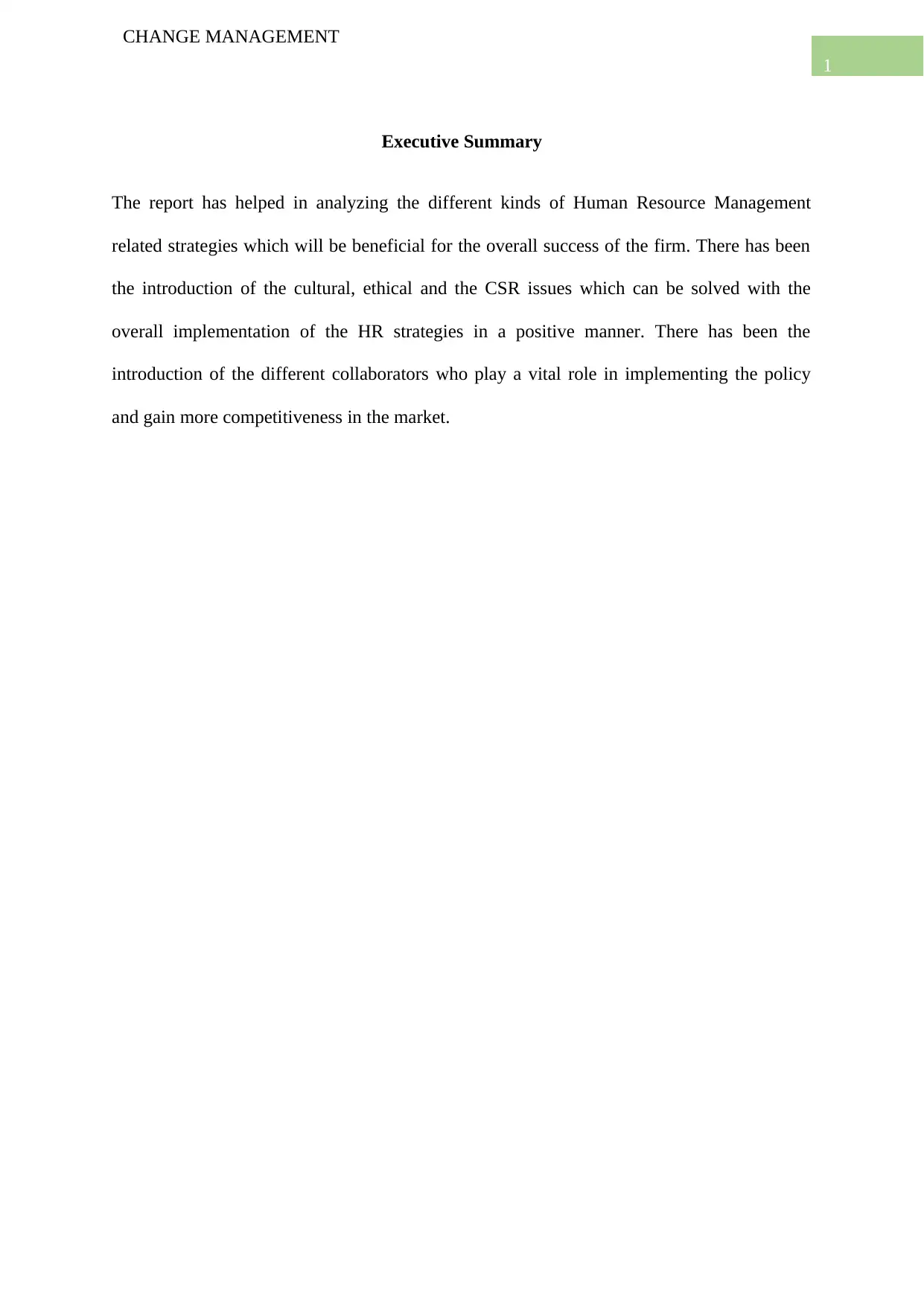
1
CHANGE MANAGEMENT
Executive Summary
The report has helped in analyzing the different kinds of Human Resource Management
related strategies which will be beneficial for the overall success of the firm. There has been
the introduction of the cultural, ethical and the CSR issues which can be solved with the
overall implementation of the HR strategies in a positive manner. There has been the
introduction of the different collaborators who play a vital role in implementing the policy
and gain more competitiveness in the market.
CHANGE MANAGEMENT
Executive Summary
The report has helped in analyzing the different kinds of Human Resource Management
related strategies which will be beneficial for the overall success of the firm. There has been
the introduction of the cultural, ethical and the CSR issues which can be solved with the
overall implementation of the HR strategies in a positive manner. There has been the
introduction of the different collaborators who play a vital role in implementing the policy
and gain more competitiveness in the market.
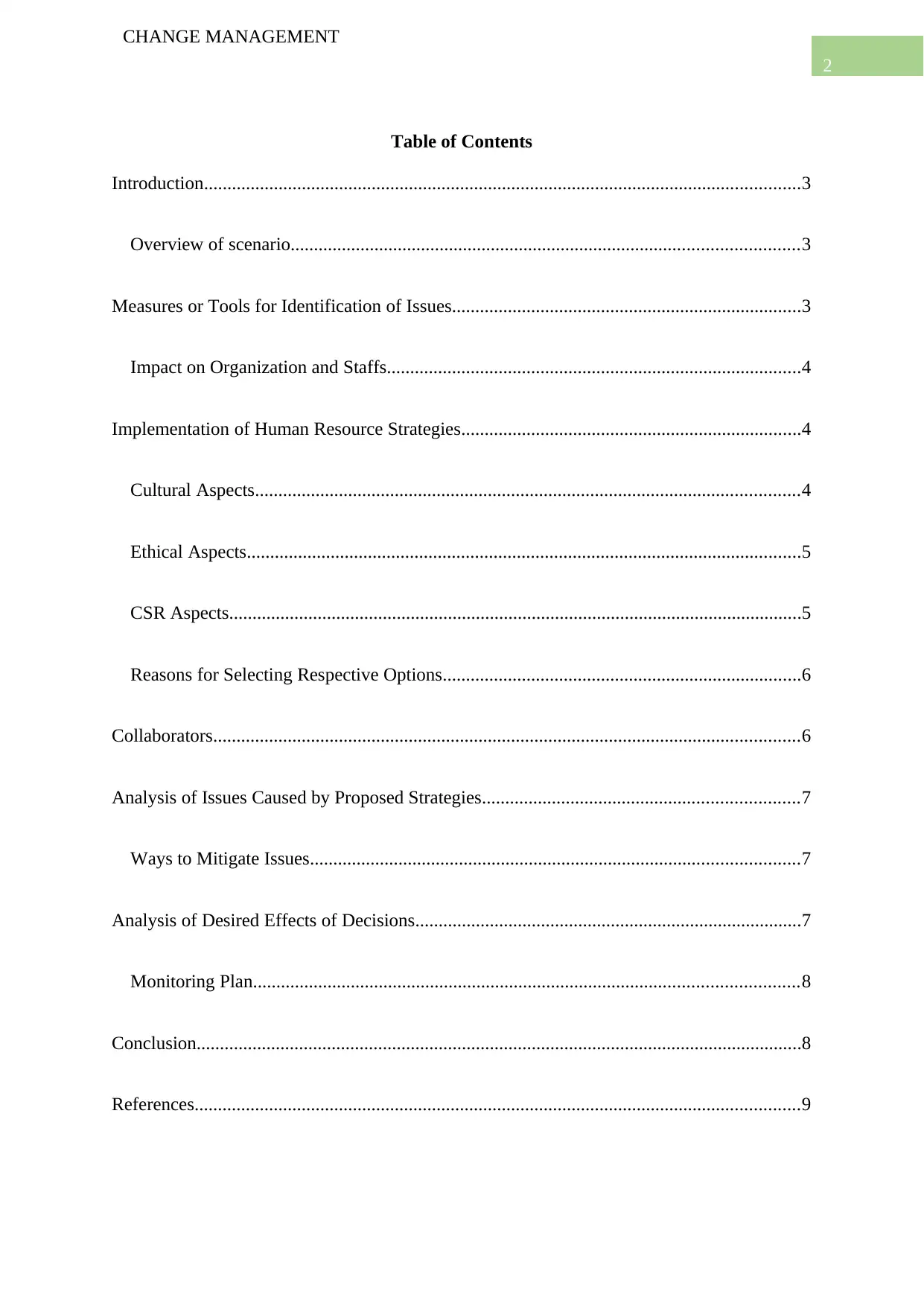
2
CHANGE MANAGEMENT
Table of Contents
Introduction................................................................................................................................3
Overview of scenario.............................................................................................................3
Measures or Tools for Identification of Issues...........................................................................3
Impact on Organization and Staffs.........................................................................................4
Implementation of Human Resource Strategies.........................................................................4
Cultural Aspects.....................................................................................................................4
Ethical Aspects.......................................................................................................................5
CSR Aspects...........................................................................................................................5
Reasons for Selecting Respective Options.............................................................................6
Collaborators..............................................................................................................................6
Analysis of Issues Caused by Proposed Strategies....................................................................7
Ways to Mitigate Issues.........................................................................................................7
Analysis of Desired Effects of Decisions...................................................................................7
Monitoring Plan.....................................................................................................................8
Conclusion..................................................................................................................................8
References..................................................................................................................................9
CHANGE MANAGEMENT
Table of Contents
Introduction................................................................................................................................3
Overview of scenario.............................................................................................................3
Measures or Tools for Identification of Issues...........................................................................3
Impact on Organization and Staffs.........................................................................................4
Implementation of Human Resource Strategies.........................................................................4
Cultural Aspects.....................................................................................................................4
Ethical Aspects.......................................................................................................................5
CSR Aspects...........................................................................................................................5
Reasons for Selecting Respective Options.............................................................................6
Collaborators..............................................................................................................................6
Analysis of Issues Caused by Proposed Strategies....................................................................7
Ways to Mitigate Issues.........................................................................................................7
Analysis of Desired Effects of Decisions...................................................................................7
Monitoring Plan.....................................................................................................................8
Conclusion..................................................................................................................................8
References..................................................................................................................................9
⊘ This is a preview!⊘
Do you want full access?
Subscribe today to unlock all pages.

Trusted by 1+ million students worldwide
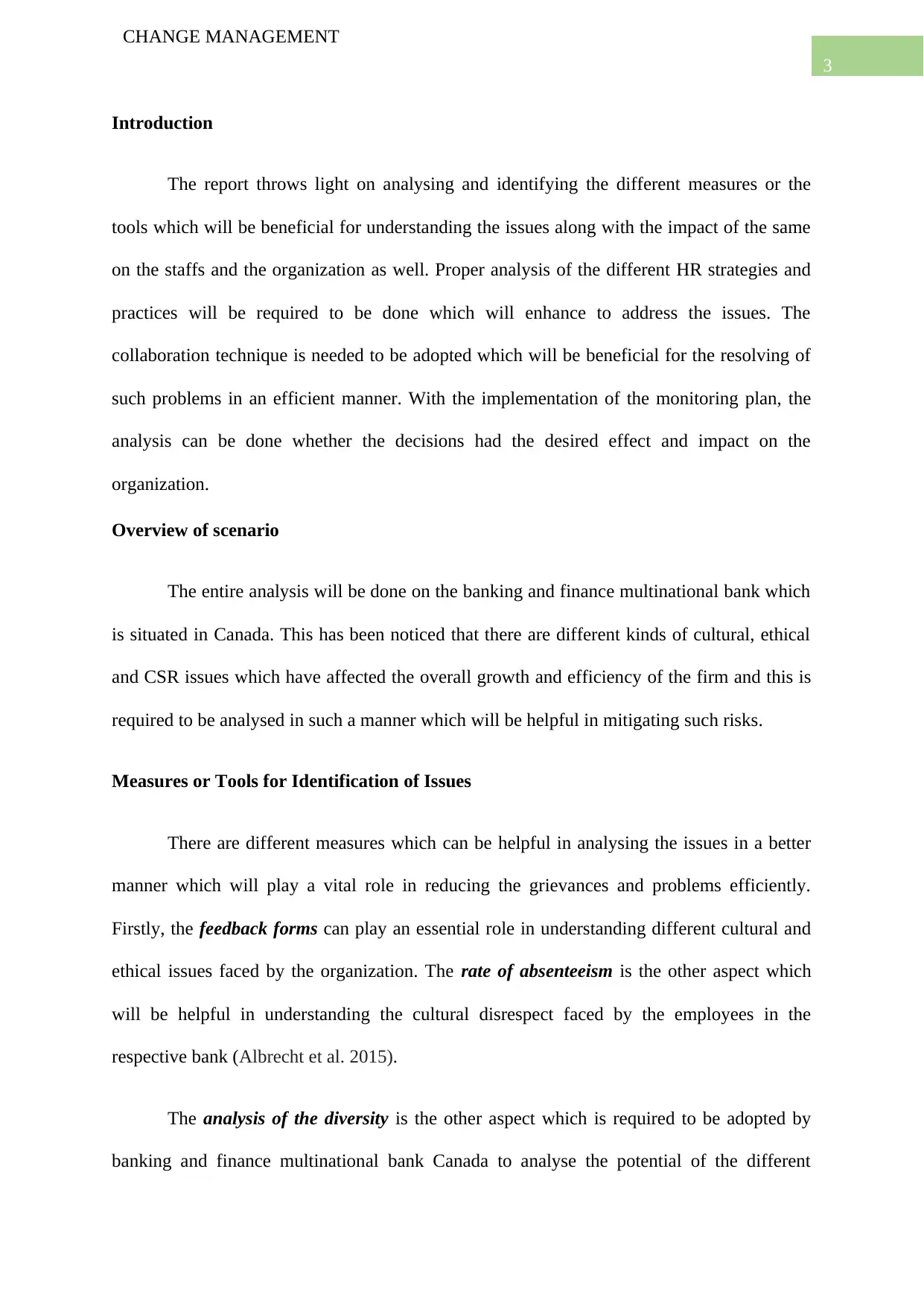
3
CHANGE MANAGEMENT
Introduction
The report throws light on analysing and identifying the different measures or the
tools which will be beneficial for understanding the issues along with the impact of the same
on the staffs and the organization as well. Proper analysis of the different HR strategies and
practices will be required to be done which will enhance to address the issues. The
collaboration technique is needed to be adopted which will be beneficial for the resolving of
such problems in an efficient manner. With the implementation of the monitoring plan, the
analysis can be done whether the decisions had the desired effect and impact on the
organization.
Overview of scenario
The entire analysis will be done on the banking and finance multinational bank which
is situated in Canada. This has been noticed that there are different kinds of cultural, ethical
and CSR issues which have affected the overall growth and efficiency of the firm and this is
required to be analysed in such a manner which will be helpful in mitigating such risks.
Measures or Tools for Identification of Issues
There are different measures which can be helpful in analysing the issues in a better
manner which will play a vital role in reducing the grievances and problems efficiently.
Firstly, the feedback forms can play an essential role in understanding different cultural and
ethical issues faced by the organization. The rate of absenteeism is the other aspect which
will be helpful in understanding the cultural disrespect faced by the employees in the
respective bank (Albrecht et al. 2015).
The analysis of the diversity is the other aspect which is required to be adopted by
banking and finance multinational bank Canada to analyse the potential of the different
CHANGE MANAGEMENT
Introduction
The report throws light on analysing and identifying the different measures or the
tools which will be beneficial for understanding the issues along with the impact of the same
on the staffs and the organization as well. Proper analysis of the different HR strategies and
practices will be required to be done which will enhance to address the issues. The
collaboration technique is needed to be adopted which will be beneficial for the resolving of
such problems in an efficient manner. With the implementation of the monitoring plan, the
analysis can be done whether the decisions had the desired effect and impact on the
organization.
Overview of scenario
The entire analysis will be done on the banking and finance multinational bank which
is situated in Canada. This has been noticed that there are different kinds of cultural, ethical
and CSR issues which have affected the overall growth and efficiency of the firm and this is
required to be analysed in such a manner which will be helpful in mitigating such risks.
Measures or Tools for Identification of Issues
There are different measures which can be helpful in analysing the issues in a better
manner which will play a vital role in reducing the grievances and problems efficiently.
Firstly, the feedback forms can play an essential role in understanding different cultural and
ethical issues faced by the organization. The rate of absenteeism is the other aspect which
will be helpful in understanding the cultural disrespect faced by the employees in the
respective bank (Albrecht et al. 2015).
The analysis of the diversity is the other aspect which is required to be adopted by
banking and finance multinational bank Canada to analyse the potential of the different
Paraphrase This Document
Need a fresh take? Get an instant paraphrase of this document with our AI Paraphraser
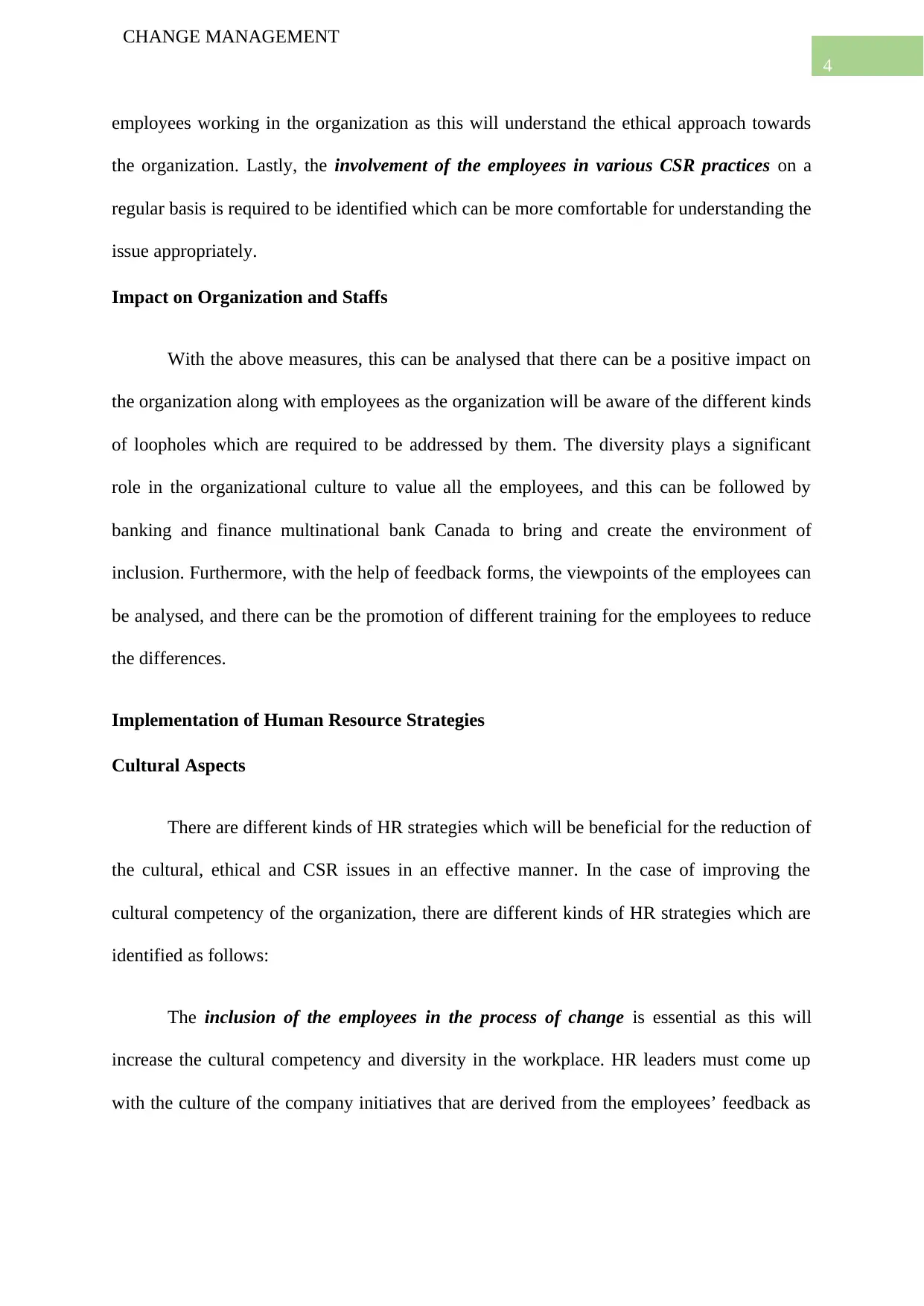
4
CHANGE MANAGEMENT
employees working in the organization as this will understand the ethical approach towards
the organization. Lastly, the involvement of the employees in various CSR practices on a
regular basis is required to be identified which can be more comfortable for understanding the
issue appropriately.
Impact on Organization and Staffs
With the above measures, this can be analysed that there can be a positive impact on
the organization along with employees as the organization will be aware of the different kinds
of loopholes which are required to be addressed by them. The diversity plays a significant
role in the organizational culture to value all the employees, and this can be followed by
banking and finance multinational bank Canada to bring and create the environment of
inclusion. Furthermore, with the help of feedback forms, the viewpoints of the employees can
be analysed, and there can be the promotion of different training for the employees to reduce
the differences.
Implementation of Human Resource Strategies
Cultural Aspects
There are different kinds of HR strategies which will be beneficial for the reduction of
the cultural, ethical and CSR issues in an effective manner. In the case of improving the
cultural competency of the organization, there are different kinds of HR strategies which are
identified as follows:
The inclusion of the employees in the process of change is essential as this will
increase the cultural competency and diversity in the workplace. HR leaders must come up
with the culture of the company initiatives that are derived from the employees’ feedback as
CHANGE MANAGEMENT
employees working in the organization as this will understand the ethical approach towards
the organization. Lastly, the involvement of the employees in various CSR practices on a
regular basis is required to be identified which can be more comfortable for understanding the
issue appropriately.
Impact on Organization and Staffs
With the above measures, this can be analysed that there can be a positive impact on
the organization along with employees as the organization will be aware of the different kinds
of loopholes which are required to be addressed by them. The diversity plays a significant
role in the organizational culture to value all the employees, and this can be followed by
banking and finance multinational bank Canada to bring and create the environment of
inclusion. Furthermore, with the help of feedback forms, the viewpoints of the employees can
be analysed, and there can be the promotion of different training for the employees to reduce
the differences.
Implementation of Human Resource Strategies
Cultural Aspects
There are different kinds of HR strategies which will be beneficial for the reduction of
the cultural, ethical and CSR issues in an effective manner. In the case of improving the
cultural competency of the organization, there are different kinds of HR strategies which are
identified as follows:
The inclusion of the employees in the process of change is essential as this will
increase the cultural competency and diversity in the workplace. HR leaders must come up
with the culture of the company initiatives that are derived from the employees’ feedback as
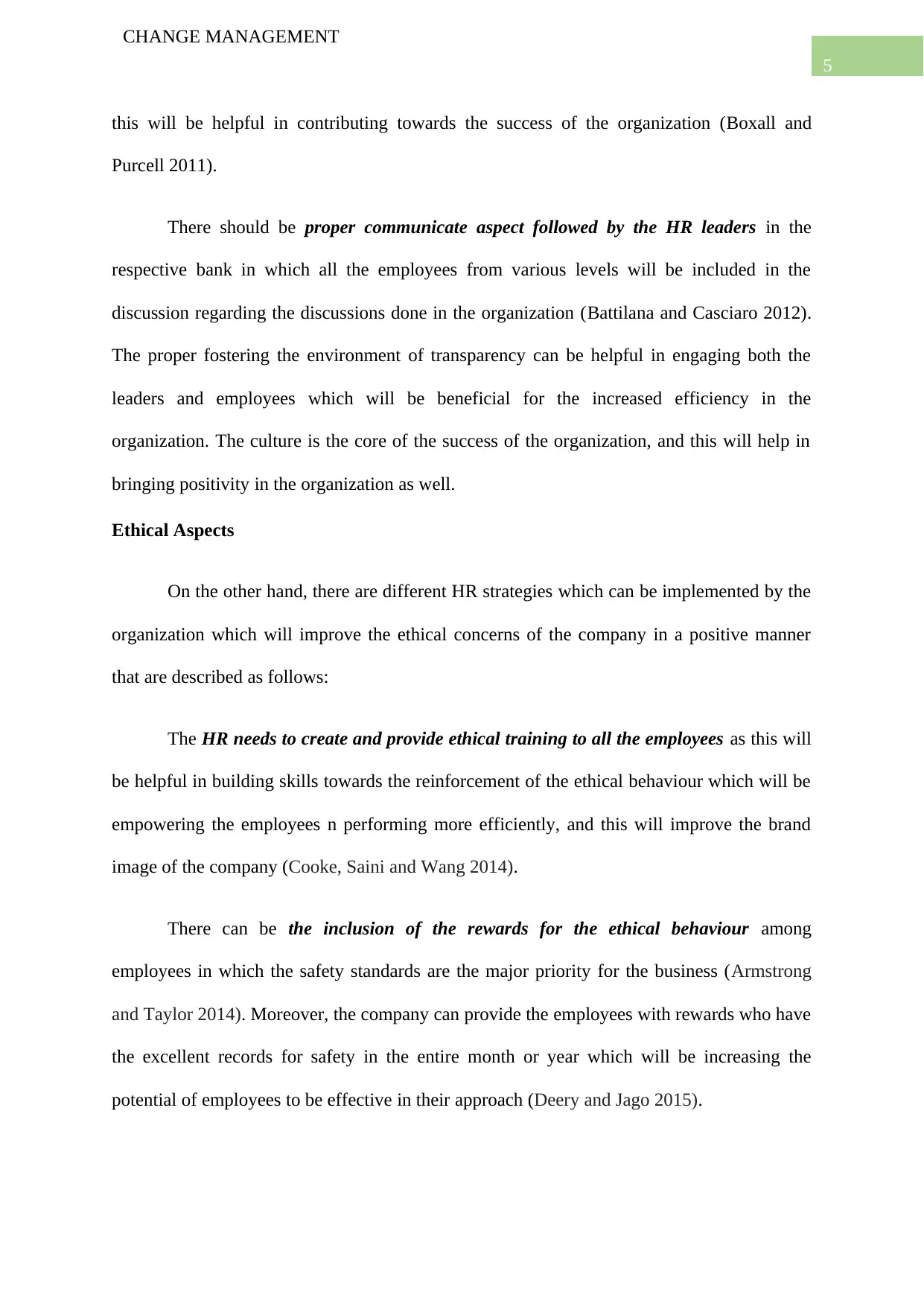
5
CHANGE MANAGEMENT
this will be helpful in contributing towards the success of the organization (Boxall and
Purcell 2011).
There should be proper communicate aspect followed by the HR leaders in the
respective bank in which all the employees from various levels will be included in the
discussion regarding the discussions done in the organization (Battilana and Casciaro 2012).
The proper fostering the environment of transparency can be helpful in engaging both the
leaders and employees which will be beneficial for the increased efficiency in the
organization. The culture is the core of the success of the organization, and this will help in
bringing positivity in the organization as well.
Ethical Aspects
On the other hand, there are different HR strategies which can be implemented by the
organization which will improve the ethical concerns of the company in a positive manner
that are described as follows:
The HR needs to create and provide ethical training to all the employees as this will
be helpful in building skills towards the reinforcement of the ethical behaviour which will be
empowering the employees n performing more efficiently, and this will improve the brand
image of the company (Cooke, Saini and Wang 2014).
There can be the inclusion of the rewards for the ethical behaviour among
employees in which the safety standards are the major priority for the business (Armstrong
and Taylor 2014). Moreover, the company can provide the employees with rewards who have
the excellent records for safety in the entire month or year which will be increasing the
potential of employees to be effective in their approach (Deery and Jago 2015).
CHANGE MANAGEMENT
this will be helpful in contributing towards the success of the organization (Boxall and
Purcell 2011).
There should be proper communicate aspect followed by the HR leaders in the
respective bank in which all the employees from various levels will be included in the
discussion regarding the discussions done in the organization (Battilana and Casciaro 2012).
The proper fostering the environment of transparency can be helpful in engaging both the
leaders and employees which will be beneficial for the increased efficiency in the
organization. The culture is the core of the success of the organization, and this will help in
bringing positivity in the organization as well.
Ethical Aspects
On the other hand, there are different HR strategies which can be implemented by the
organization which will improve the ethical concerns of the company in a positive manner
that are described as follows:
The HR needs to create and provide ethical training to all the employees as this will
be helpful in building skills towards the reinforcement of the ethical behaviour which will be
empowering the employees n performing more efficiently, and this will improve the brand
image of the company (Cooke, Saini and Wang 2014).
There can be the inclusion of the rewards for the ethical behaviour among
employees in which the safety standards are the major priority for the business (Armstrong
and Taylor 2014). Moreover, the company can provide the employees with rewards who have
the excellent records for safety in the entire month or year which will be increasing the
potential of employees to be effective in their approach (Deery and Jago 2015).
⊘ This is a preview!⊘
Do you want full access?
Subscribe today to unlock all pages.

Trusted by 1+ million students worldwide
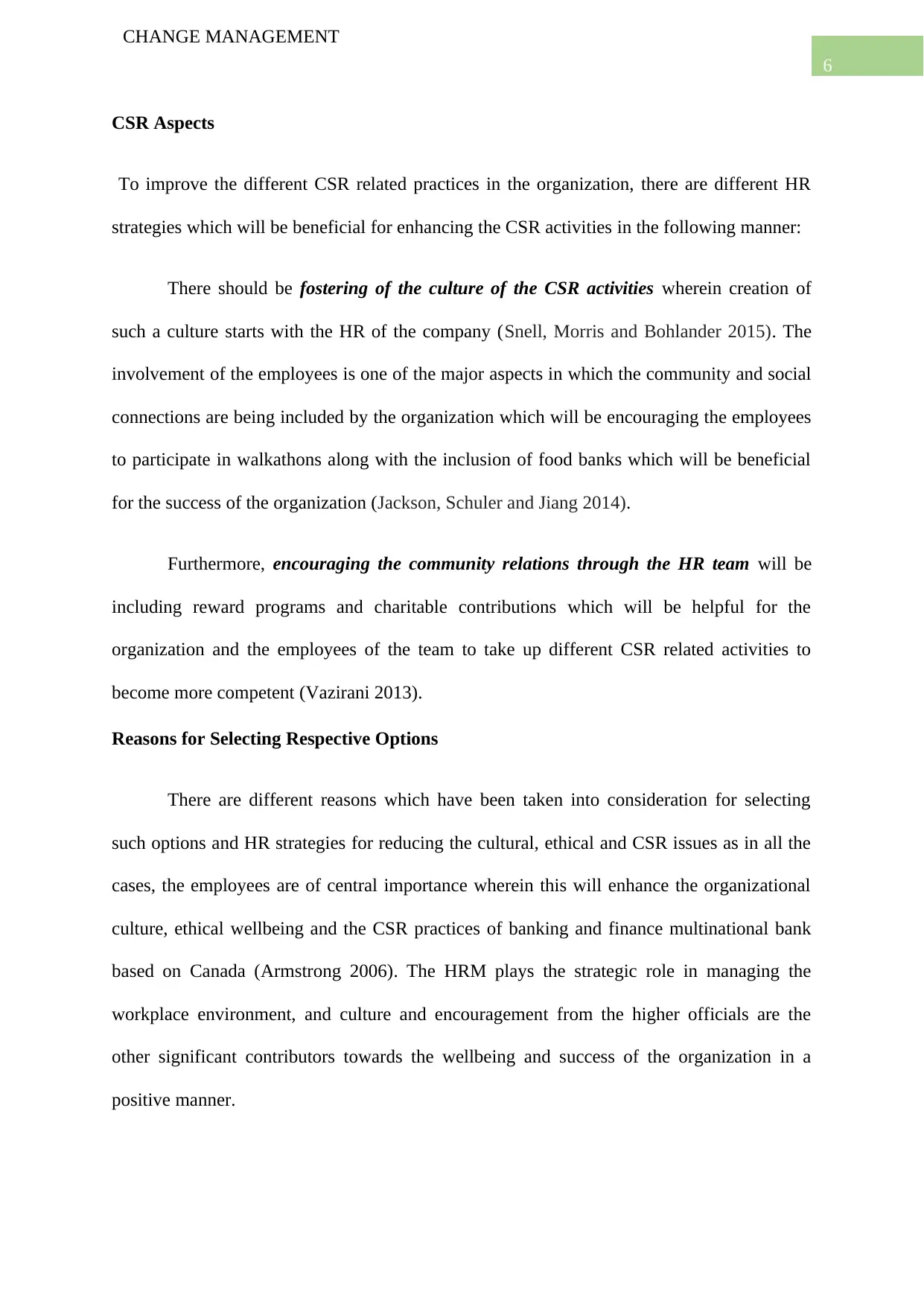
6
CHANGE MANAGEMENT
CSR Aspects
To improve the different CSR related practices in the organization, there are different HR
strategies which will be beneficial for enhancing the CSR activities in the following manner:
There should be fostering of the culture of the CSR activities wherein creation of
such a culture starts with the HR of the company (Snell, Morris and Bohlander 2015). The
involvement of the employees is one of the major aspects in which the community and social
connections are being included by the organization which will be encouraging the employees
to participate in walkathons along with the inclusion of food banks which will be beneficial
for the success of the organization (Jackson, Schuler and Jiang 2014).
Furthermore, encouraging the community relations through the HR team will be
including reward programs and charitable contributions which will be helpful for the
organization and the employees of the team to take up different CSR related activities to
become more competent (Vazirani 2013).
Reasons for Selecting Respective Options
There are different reasons which have been taken into consideration for selecting
such options and HR strategies for reducing the cultural, ethical and CSR issues as in all the
cases, the employees are of central importance wherein this will enhance the organizational
culture, ethical wellbeing and the CSR practices of banking and finance multinational bank
based on Canada (Armstrong 2006). The HRM plays the strategic role in managing the
workplace environment, and culture and encouragement from the higher officials are the
other significant contributors towards the wellbeing and success of the organization in a
positive manner.
CHANGE MANAGEMENT
CSR Aspects
To improve the different CSR related practices in the organization, there are different HR
strategies which will be beneficial for enhancing the CSR activities in the following manner:
There should be fostering of the culture of the CSR activities wherein creation of
such a culture starts with the HR of the company (Snell, Morris and Bohlander 2015). The
involvement of the employees is one of the major aspects in which the community and social
connections are being included by the organization which will be encouraging the employees
to participate in walkathons along with the inclusion of food banks which will be beneficial
for the success of the organization (Jackson, Schuler and Jiang 2014).
Furthermore, encouraging the community relations through the HR team will be
including reward programs and charitable contributions which will be helpful for the
organization and the employees of the team to take up different CSR related activities to
become more competent (Vazirani 2013).
Reasons for Selecting Respective Options
There are different reasons which have been taken into consideration for selecting
such options and HR strategies for reducing the cultural, ethical and CSR issues as in all the
cases, the employees are of central importance wherein this will enhance the organizational
culture, ethical wellbeing and the CSR practices of banking and finance multinational bank
based on Canada (Armstrong 2006). The HRM plays the strategic role in managing the
workplace environment, and culture and encouragement from the higher officials are the
other significant contributors towards the wellbeing and success of the organization in a
positive manner.
Paraphrase This Document
Need a fresh take? Get an instant paraphrase of this document with our AI Paraphraser
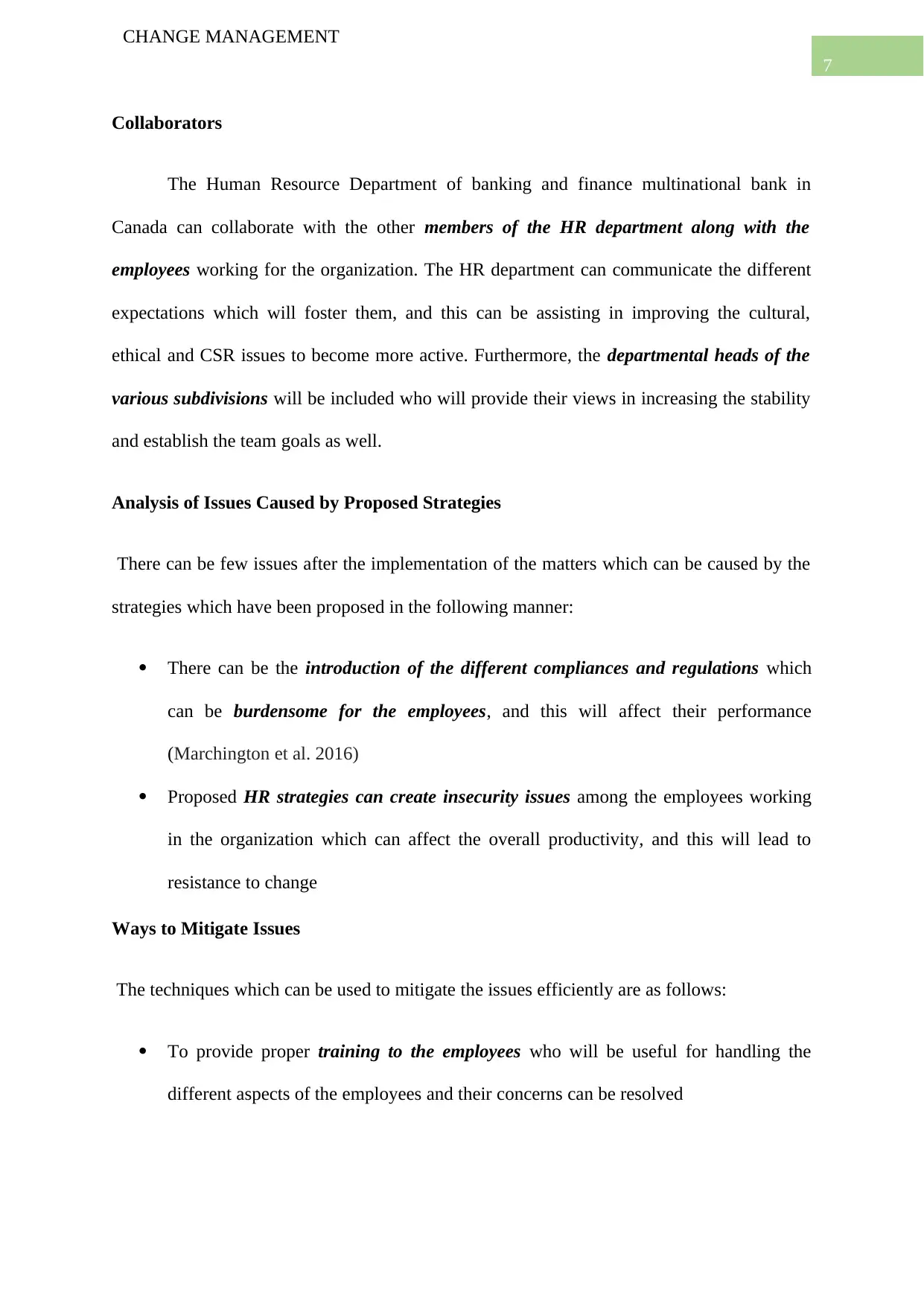
7
CHANGE MANAGEMENT
Collaborators
The Human Resource Department of banking and finance multinational bank in
Canada can collaborate with the other members of the HR department along with the
employees working for the organization. The HR department can communicate the different
expectations which will foster them, and this can be assisting in improving the cultural,
ethical and CSR issues to become more active. Furthermore, the departmental heads of the
various subdivisions will be included who will provide their views in increasing the stability
and establish the team goals as well.
Analysis of Issues Caused by Proposed Strategies
There can be few issues after the implementation of the matters which can be caused by the
strategies which have been proposed in the following manner:
There can be the introduction of the different compliances and regulations which
can be burdensome for the employees, and this will affect their performance
(Marchington et al. 2016)
Proposed HR strategies can create insecurity issues among the employees working
in the organization which can affect the overall productivity, and this will lead to
resistance to change
Ways to Mitigate Issues
The techniques which can be used to mitigate the issues efficiently are as follows:
To provide proper training to the employees who will be useful for handling the
different aspects of the employees and their concerns can be resolved
CHANGE MANAGEMENT
Collaborators
The Human Resource Department of banking and finance multinational bank in
Canada can collaborate with the other members of the HR department along with the
employees working for the organization. The HR department can communicate the different
expectations which will foster them, and this can be assisting in improving the cultural,
ethical and CSR issues to become more active. Furthermore, the departmental heads of the
various subdivisions will be included who will provide their views in increasing the stability
and establish the team goals as well.
Analysis of Issues Caused by Proposed Strategies
There can be few issues after the implementation of the matters which can be caused by the
strategies which have been proposed in the following manner:
There can be the introduction of the different compliances and regulations which
can be burdensome for the employees, and this will affect their performance
(Marchington et al. 2016)
Proposed HR strategies can create insecurity issues among the employees working
in the organization which can affect the overall productivity, and this will lead to
resistance to change
Ways to Mitigate Issues
The techniques which can be used to mitigate the issues efficiently are as follows:
To provide proper training to the employees who will be useful for handling the
different aspects of the employees and their concerns can be resolved
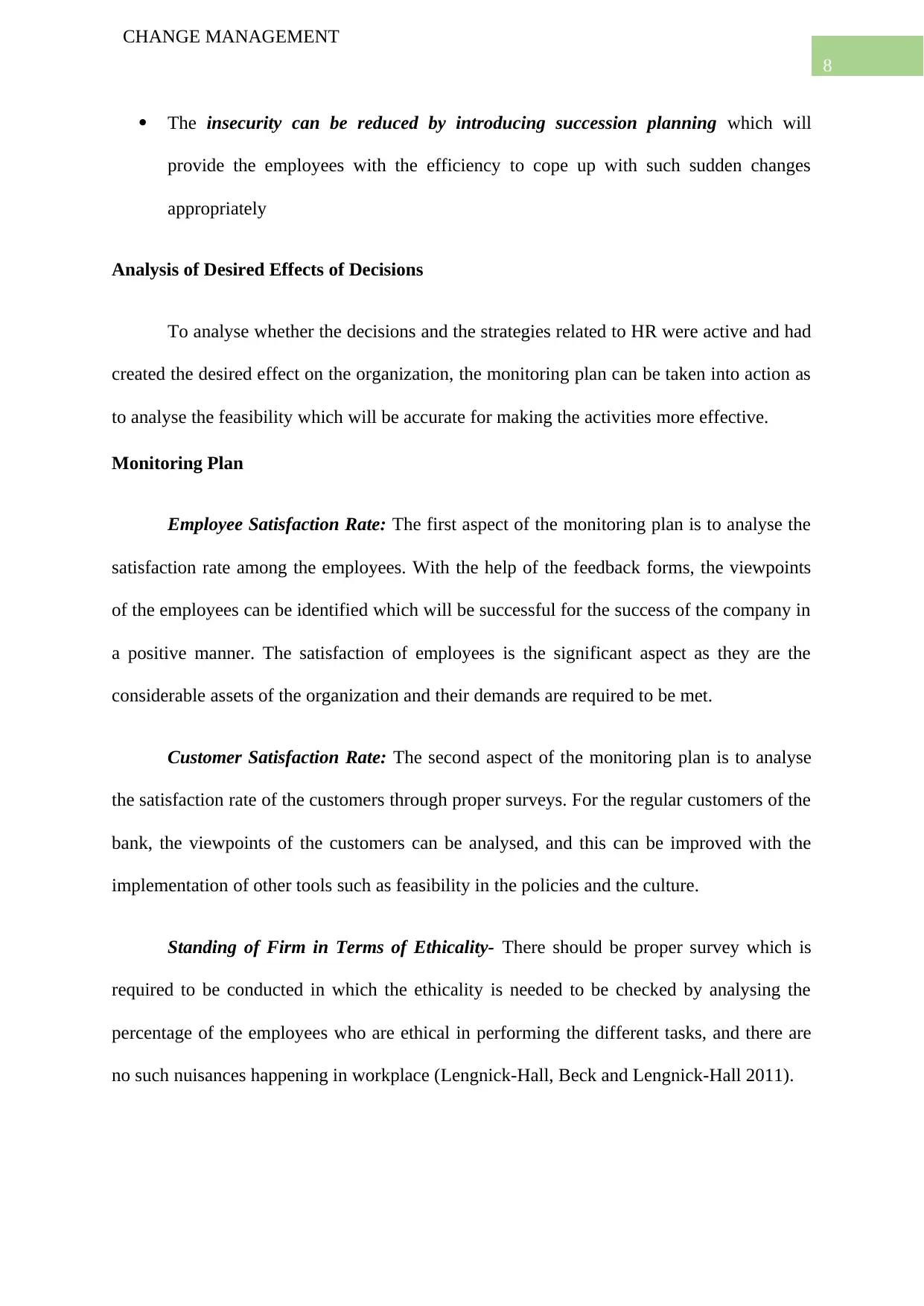
8
CHANGE MANAGEMENT
The insecurity can be reduced by introducing succession planning which will
provide the employees with the efficiency to cope up with such sudden changes
appropriately
Analysis of Desired Effects of Decisions
To analyse whether the decisions and the strategies related to HR were active and had
created the desired effect on the organization, the monitoring plan can be taken into action as
to analyse the feasibility which will be accurate for making the activities more effective.
Monitoring Plan
Employee Satisfaction Rate: The first aspect of the monitoring plan is to analyse the
satisfaction rate among the employees. With the help of the feedback forms, the viewpoints
of the employees can be identified which will be successful for the success of the company in
a positive manner. The satisfaction of employees is the significant aspect as they are the
considerable assets of the organization and their demands are required to be met.
Customer Satisfaction Rate: The second aspect of the monitoring plan is to analyse
the satisfaction rate of the customers through proper surveys. For the regular customers of the
bank, the viewpoints of the customers can be analysed, and this can be improved with the
implementation of other tools such as feasibility in the policies and the culture.
Standing of Firm in Terms of Ethicality- There should be proper survey which is
required to be conducted in which the ethicality is needed to be checked by analysing the
percentage of the employees who are ethical in performing the different tasks, and there are
no such nuisances happening in workplace (Lengnick-Hall, Beck and Lengnick-Hall 2011).
CHANGE MANAGEMENT
The insecurity can be reduced by introducing succession planning which will
provide the employees with the efficiency to cope up with such sudden changes
appropriately
Analysis of Desired Effects of Decisions
To analyse whether the decisions and the strategies related to HR were active and had
created the desired effect on the organization, the monitoring plan can be taken into action as
to analyse the feasibility which will be accurate for making the activities more effective.
Monitoring Plan
Employee Satisfaction Rate: The first aspect of the monitoring plan is to analyse the
satisfaction rate among the employees. With the help of the feedback forms, the viewpoints
of the employees can be identified which will be successful for the success of the company in
a positive manner. The satisfaction of employees is the significant aspect as they are the
considerable assets of the organization and their demands are required to be met.
Customer Satisfaction Rate: The second aspect of the monitoring plan is to analyse
the satisfaction rate of the customers through proper surveys. For the regular customers of the
bank, the viewpoints of the customers can be analysed, and this can be improved with the
implementation of other tools such as feasibility in the policies and the culture.
Standing of Firm in Terms of Ethicality- There should be proper survey which is
required to be conducted in which the ethicality is needed to be checked by analysing the
percentage of the employees who are ethical in performing the different tasks, and there are
no such nuisances happening in workplace (Lengnick-Hall, Beck and Lengnick-Hall 2011).
⊘ This is a preview!⊘
Do you want full access?
Subscribe today to unlock all pages.

Trusted by 1+ million students worldwide
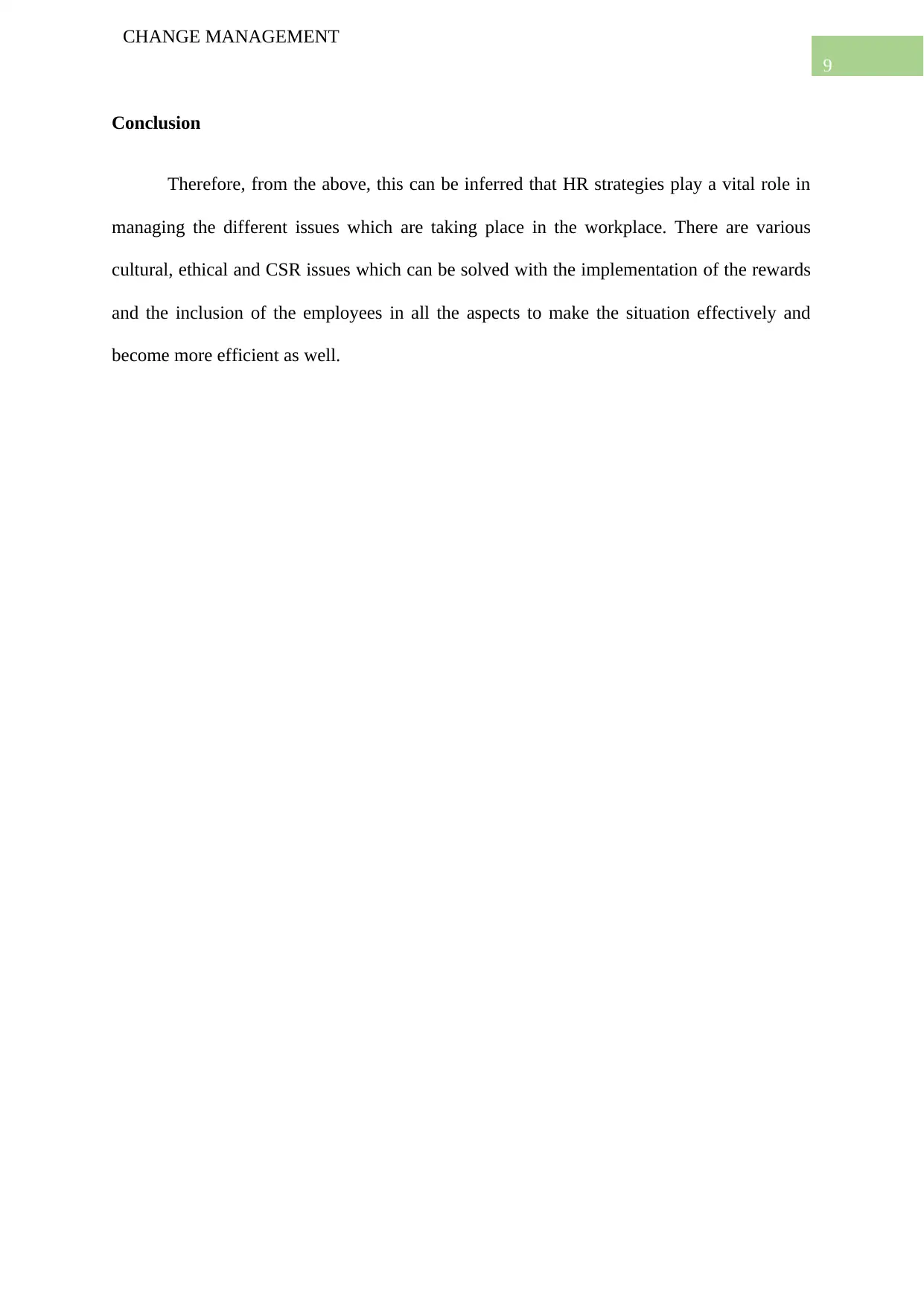
9
CHANGE MANAGEMENT
Conclusion
Therefore, from the above, this can be inferred that HR strategies play a vital role in
managing the different issues which are taking place in the workplace. There are various
cultural, ethical and CSR issues which can be solved with the implementation of the rewards
and the inclusion of the employees in all the aspects to make the situation effectively and
become more efficient as well.
CHANGE MANAGEMENT
Conclusion
Therefore, from the above, this can be inferred that HR strategies play a vital role in
managing the different issues which are taking place in the workplace. There are various
cultural, ethical and CSR issues which can be solved with the implementation of the rewards
and the inclusion of the employees in all the aspects to make the situation effectively and
become more efficient as well.
Paraphrase This Document
Need a fresh take? Get an instant paraphrase of this document with our AI Paraphraser
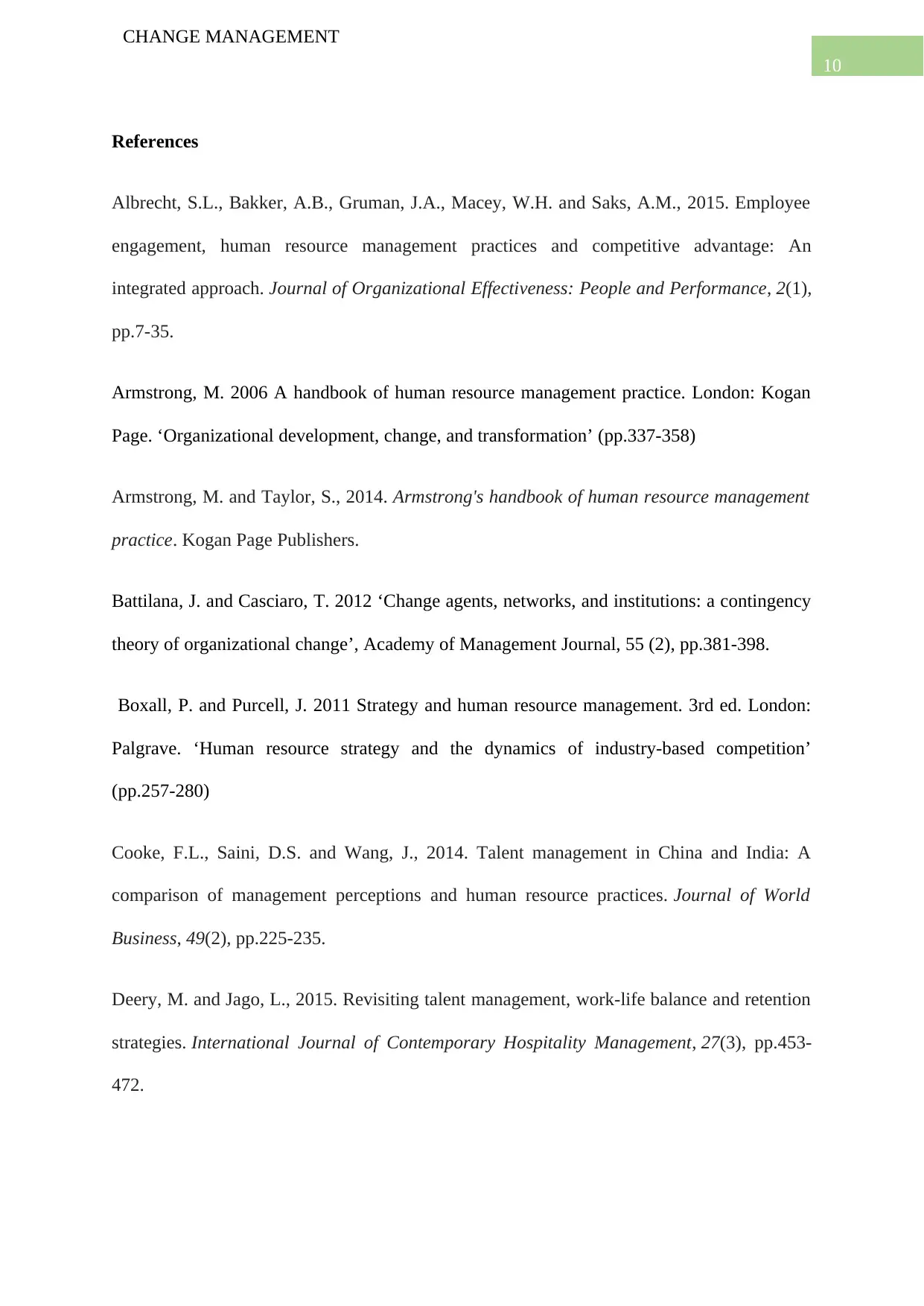
10
CHANGE MANAGEMENT
References
Albrecht, S.L., Bakker, A.B., Gruman, J.A., Macey, W.H. and Saks, A.M., 2015. Employee
engagement, human resource management practices and competitive advantage: An
integrated approach. Journal of Organizational Effectiveness: People and Performance, 2(1),
pp.7-35.
Armstrong, M. 2006 A handbook of human resource management practice. London: Kogan
Page. ‘Organizational development, change, and transformation’ (pp.337-358)
Armstrong, M. and Taylor, S., 2014. Armstrong's handbook of human resource management
practice. Kogan Page Publishers.
Battilana, J. and Casciaro, T. 2012 ‘Change agents, networks, and institutions: a contingency
theory of organizational change’, Academy of Management Journal, 55 (2), pp.381-398.
Boxall, P. and Purcell, J. 2011 Strategy and human resource management. 3rd ed. London:
Palgrave. ‘Human resource strategy and the dynamics of industry-based competition’
(pp.257-280)
Cooke, F.L., Saini, D.S. and Wang, J., 2014. Talent management in China and India: A
comparison of management perceptions and human resource practices. Journal of World
Business, 49(2), pp.225-235.
Deery, M. and Jago, L., 2015. Revisiting talent management, work-life balance and retention
strategies. International Journal of Contemporary Hospitality Management, 27(3), pp.453-
472.
CHANGE MANAGEMENT
References
Albrecht, S.L., Bakker, A.B., Gruman, J.A., Macey, W.H. and Saks, A.M., 2015. Employee
engagement, human resource management practices and competitive advantage: An
integrated approach. Journal of Organizational Effectiveness: People and Performance, 2(1),
pp.7-35.
Armstrong, M. 2006 A handbook of human resource management practice. London: Kogan
Page. ‘Organizational development, change, and transformation’ (pp.337-358)
Armstrong, M. and Taylor, S., 2014. Armstrong's handbook of human resource management
practice. Kogan Page Publishers.
Battilana, J. and Casciaro, T. 2012 ‘Change agents, networks, and institutions: a contingency
theory of organizational change’, Academy of Management Journal, 55 (2), pp.381-398.
Boxall, P. and Purcell, J. 2011 Strategy and human resource management. 3rd ed. London:
Palgrave. ‘Human resource strategy and the dynamics of industry-based competition’
(pp.257-280)
Cooke, F.L., Saini, D.S. and Wang, J., 2014. Talent management in China and India: A
comparison of management perceptions and human resource practices. Journal of World
Business, 49(2), pp.225-235.
Deery, M. and Jago, L., 2015. Revisiting talent management, work-life balance and retention
strategies. International Journal of Contemporary Hospitality Management, 27(3), pp.453-
472.
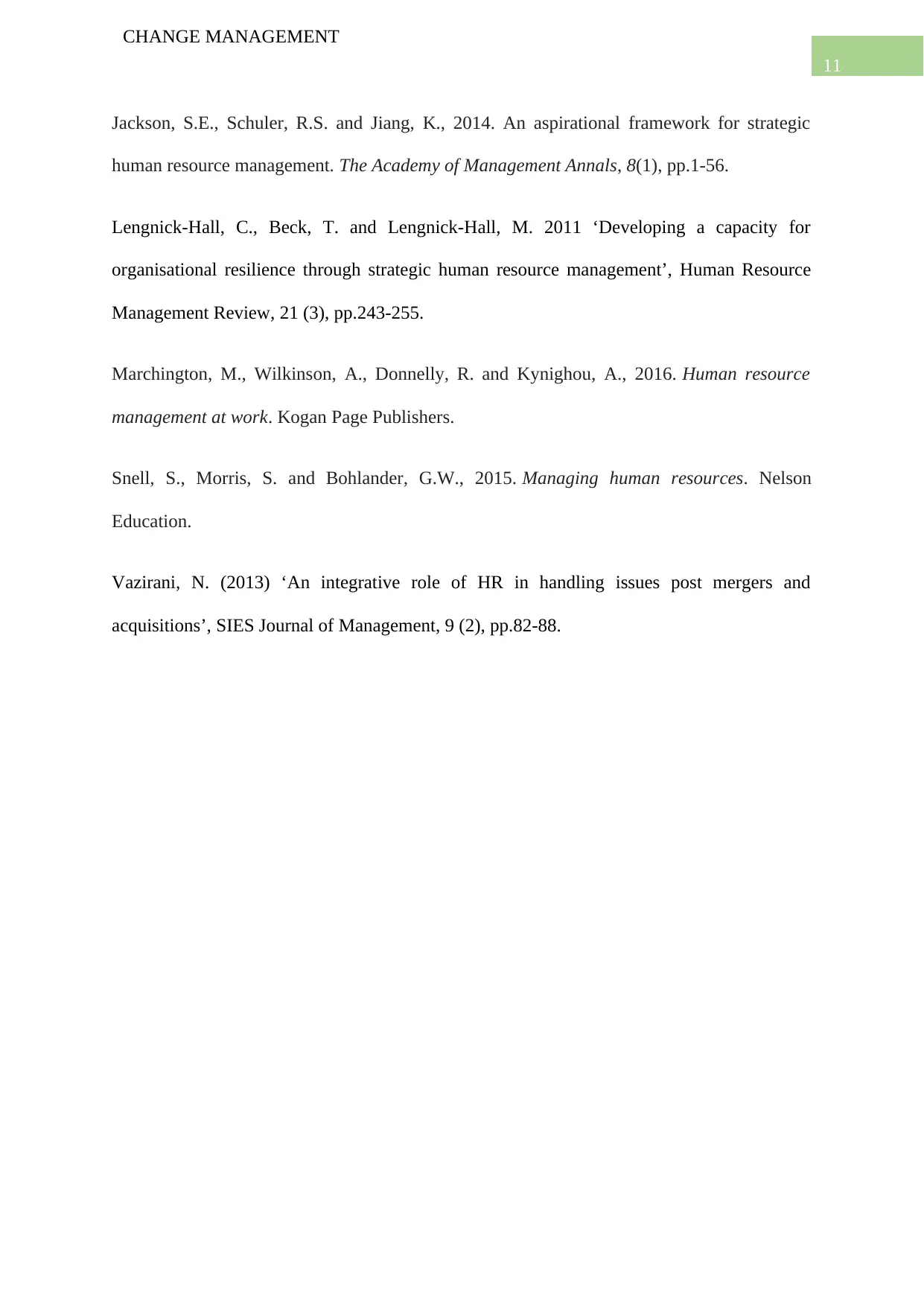
11
CHANGE MANAGEMENT
Jackson, S.E., Schuler, R.S. and Jiang, K., 2014. An aspirational framework for strategic
human resource management. The Academy of Management Annals, 8(1), pp.1-56.
Lengnick-Hall, C., Beck, T. and Lengnick-Hall, M. 2011 ‘Developing a capacity for
organisational resilience through strategic human resource management’, Human Resource
Management Review, 21 (3), pp.243-255.
Marchington, M., Wilkinson, A., Donnelly, R. and Kynighou, A., 2016. Human resource
management at work. Kogan Page Publishers.
Snell, S., Morris, S. and Bohlander, G.W., 2015. Managing human resources. Nelson
Education.
Vazirani, N. (2013) ‘An integrative role of HR in handling issues post mergers and
acquisitions’, SIES Journal of Management, 9 (2), pp.82-88.
CHANGE MANAGEMENT
Jackson, S.E., Schuler, R.S. and Jiang, K., 2014. An aspirational framework for strategic
human resource management. The Academy of Management Annals, 8(1), pp.1-56.
Lengnick-Hall, C., Beck, T. and Lengnick-Hall, M. 2011 ‘Developing a capacity for
organisational resilience through strategic human resource management’, Human Resource
Management Review, 21 (3), pp.243-255.
Marchington, M., Wilkinson, A., Donnelly, R. and Kynighou, A., 2016. Human resource
management at work. Kogan Page Publishers.
Snell, S., Morris, S. and Bohlander, G.W., 2015. Managing human resources. Nelson
Education.
Vazirani, N. (2013) ‘An integrative role of HR in handling issues post mergers and
acquisitions’, SIES Journal of Management, 9 (2), pp.82-88.
⊘ This is a preview!⊘
Do you want full access?
Subscribe today to unlock all pages.

Trusted by 1+ million students worldwide
1 out of 12
Related Documents
Your All-in-One AI-Powered Toolkit for Academic Success.
+13062052269
info@desklib.com
Available 24*7 on WhatsApp / Email
![[object Object]](/_next/static/media/star-bottom.7253800d.svg)
Unlock your academic potential
Copyright © 2020–2025 A2Z Services. All Rights Reserved. Developed and managed by ZUCOL.





